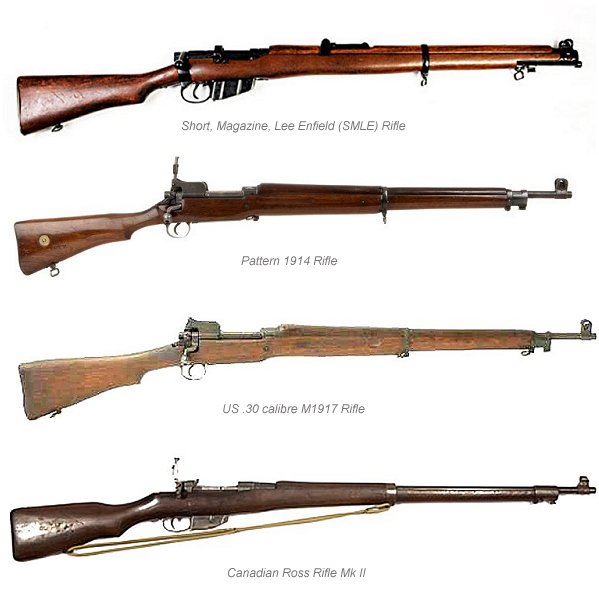yeovil at waR
RIFLES
Weapons of the Home Guard
Following the withdrawal of the British Expeditionary Force in June 1940 the British Army was very poorly equipped. The newly-formed LDV, soon to become the Home Guard, were even less well equipped. A few Home Guard units were equipped with .303 SMLE rifles but there were never enough to go around. Also, of course, following the evacuation of the BEF the prime objective was to re-arm the Army. The initial allocation of rifles to the Somerset Home Guard, for instance, was set at 200 rifles and 2,000 rounds of ammunition for the 6,000 men enrolling during the first week. The troops garrisoning the Taunton Stop Line, both regulars and Home Guard, therefore had an initial desperate shortage of weapons that was to be overcome by importing a range of rifles from America and Canada.
The Short, Magazine, Lee-Enfield (SMLE) rifle was approved for service in 1902 to replace the Lee-Metford and the 'Long' Lee-Enfield and went through a series of model changes; the SMLE Mk II was made by conversion of both the Lee-Metford Mk II* and Lee-Enfield rifles, the SMLE Mk III of 1907 had internal changes to the charger guides. Further minor modifications were made culminating in the Mk V rifle. The SMLE was the standard service rifle for the British Army during the Second World War, even after the introduction of the No 4 rifle that was produced from 1941 onwards.
Between 1910 and 1913 the British Pattern 13 rifle was developed, based on a Mauser action and initially chambered for the .276" cartridge but on the outbreak of war used the standard British Army .303" round. In 1914 arrangements were made for the rifle to be manufactured in the USA at the Remington, Winchester and Eddystone factories. This new version of the P13 for the British Army was called the 1914 Pattern rifle, or P14, rifle. When America came into the war in 1917 the 1914 Pattern rifle was made for US forces and chambered for the .30-06 cartridge and known as the US Rifle Cal .30 Model of 1917. but generally known as the M17 or simply the Enfield. 100,000 P14 and M17 rifles were purchased for use by the Home Guard in 1940 following to the shortage of rifles after Dunkirk. Because of the different calibre cartridge used in these weapons, they had a band painted around the stock to differentiate them.
In 1905 the Canadian army received the first issues of the controversial Ross rifle, a straight-pull bolt action repeating rifle designed by Sir Charles Ross. There were some thirteen different marks and models of the rifle but it was declared obsolete in 1916 when it was found that the mud of the trenches and poor initial extraction led to extensive stoppages. 75,000 Ross rifles were sent to Britain in 1940 and issued to the Home Guard.
Adapted from my e-book "A Photographic Guide to the Taunton Stop Line"
gallery

